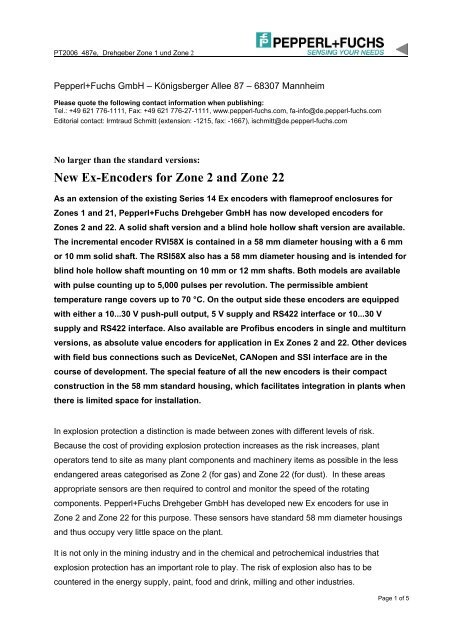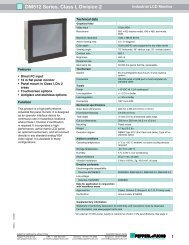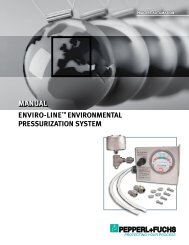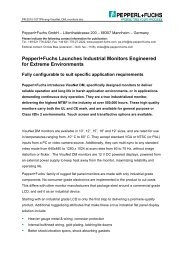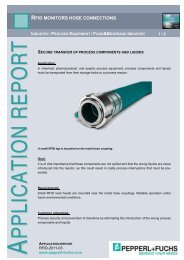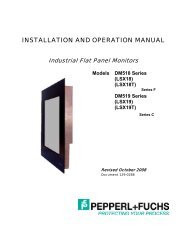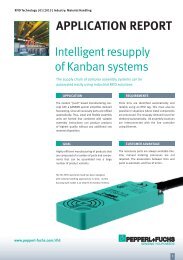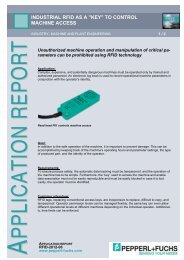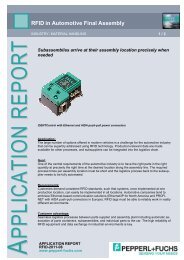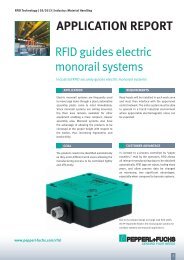New Ex-Encoders for Zone 2 and Zone 22 (PDF ... - Pepperl+Fuchs
New Ex-Encoders for Zone 2 and Zone 22 (PDF ... - Pepperl+Fuchs
New Ex-Encoders for Zone 2 and Zone 22 (PDF ... - Pepperl+Fuchs
- No tags were found...
Create successful ePaper yourself
Turn your PDF publications into a flip-book with our unique Google optimized e-Paper software.
PT2006_487e,_Drehgeber <strong>Zone</strong> 1 und <strong>Zone</strong> 2<strong>Pepperl+Fuchs</strong> GmbH – Königsberger Allee 87 – 68307 MannheimPlease quote the following contact in<strong>for</strong>mation when publishing:Tel.: +49 621 776-1111, Fax: +49 621 776-27-1111, www.pepperl-fuchs.com, fa-info@de.pepperl-fuchs.comEditorial contact: Irmtraud Schmitt (extension: -1215, fax: -1667), ischmitt@de.pepperl-fuchs.comNo larger than the st<strong>and</strong>ard versions:<strong>New</strong> <strong>Ex</strong>-<strong>Encoders</strong> <strong>for</strong> <strong>Zone</strong> 2 <strong>and</strong> <strong>Zone</strong> <strong>22</strong>As an extension of the existing Series 14 <strong>Ex</strong> encoders with flameproof enclosures <strong>for</strong><strong>Zone</strong>s 1 <strong>and</strong> 21, <strong>Pepperl+Fuchs</strong> Drehgeber GmbH has now developed encoders <strong>for</strong><strong>Zone</strong>s 2 <strong>and</strong> <strong>22</strong>. A solid shaft version <strong>and</strong> a blind hole hollow shaft version are available.The incremental encoder RVI58X is contained in a 58 mm diameter housing with a 6 mmor 10 mm solid shaft. The RSI58X also has a 58 mm diameter housing <strong>and</strong> is intended <strong>for</strong>blind hole hollow shaft mounting on 10 mm or 12 mm shafts. Both models are availablewith pulse counting up to 5,000 pulses per revolution. The permissible ambienttemperature range covers up to 70 °C. On the output side these encoders are equippedwith either a 10...30 V push-pull output, 5 V supply <strong>and</strong> RS4<strong>22</strong> interface or 10...30 Vsupply <strong>and</strong> RS4<strong>22</strong> interface. Also available are Profibus encoders in single <strong>and</strong> multiturnversions, as absolute value encoders <strong>for</strong> application in <strong>Ex</strong> <strong>Zone</strong>s 2 <strong>and</strong> <strong>22</strong>. Other deviceswith field bus connections such as DeviceNet, CANopen <strong>and</strong> SSI interface are in thecourse of development. The special feature of all the new encoders is their compactconstruction in the 58 mm st<strong>and</strong>ard housing, which facilitates integration in plants whenthere is limited space <strong>for</strong> installation.In explosion protection a distinction is made between zones with different levels of risk.Because the cost of providing explosion protection increases as the risk increases, plantoperators tend to site as many plant components <strong>and</strong> machinery items as possible in the lessendangered areas categorised as <strong>Zone</strong> 2 (<strong>for</strong> gas) <strong>and</strong> <strong>Zone</strong> <strong>22</strong> (<strong>for</strong> dust). In these areasappropriate sensors are then required to control <strong>and</strong> monitor the speed of the rotatingcomponents. <strong>Pepperl+Fuchs</strong> Drehgeber GmbH has developed new <strong>Ex</strong> encoders <strong>for</strong> use in<strong>Zone</strong> 2 <strong>and</strong> <strong>Zone</strong> <strong>22</strong> <strong>for</strong> this purpose. These sensors have st<strong>and</strong>ard 58 mm diameter housings<strong>and</strong> thus occupy very little space on the plant.It is not only in the mining industry <strong>and</strong> in the chemical <strong>and</strong> petrochemical industries thatexplosion protection has an important role to play. The risk of explosion also has to becountered in the energy supply, paint, food <strong>and</strong> drink, milling <strong>and</strong> other industries.Page 1 of 5
In all these industries <strong>and</strong> others there is the routine possibility of the presence of mixtures ofgases <strong>and</strong> dust <strong>and</strong> accordingly explosion protection precautions are a must. Although theonset of an explosive atmosphere is avoided from the outset through the application of primaryexplosion protection measures, secondary explosion protection measures have to be taken tokeep danger zones free from sources of ignition, because it is not possible to fundamentallyexclude the existence of an atmosphere capable of supporting an explosion. In such dangerzones open flames, hot surfaces, the threat of sparking, etc., are not permissible.ATEX Directive defined danger zones, device classes <strong>and</strong> protection types<strong>Ex</strong>plosion protection has been harmonised in the European Union since 2003 <strong>and</strong> set out in theso-called ATEX Directive. In accordance with the ATEX 95 Product Directive (Previously ATEX100a), after 30.06.2003 only those devices, components <strong>and</strong> protection systems that satisfy theDirective 94/9/EG (ATEX 100a) can be offered <strong>for</strong> sale. Depending on the category of device,either a test certificate from an approved test centre (EU prototype test) or a manufacturer’sdeclaration (EU certificate of con<strong>for</strong>mity) is required, which provides in<strong>for</strong>mation confirmingcompliance with the directive. A sub-division into danger zones <strong>and</strong> the definition of the classesof devices <strong>and</strong> categories specifies which requirements <strong>and</strong> protection classifications are set <strong>for</strong>the individual apparatus <strong>and</strong> where these can be used.The ignition protection classifications describe the various options <strong>for</strong> the provision of devices<strong>and</strong> apparatus <strong>for</strong> use in <strong>Ex</strong> areas. In the case of gas explosion protection there are increasedsafety, flameproof enclosures, pressurised enclosures, intrinsic safety, oil immersion, s<strong>and</strong>filling <strong>and</strong> encapsulation. In intrinsically safe circuits, <strong>for</strong> example, the electrical energy is limitedvia current strengths <strong>and</strong> voltage levels, in such a way that the minimum ignition energyrequired to cause an explosion by the generation of sparks or heating is not attained. In thecase of devices in flameproof enclosures, all the components, which could trigger an explosion,are contained in a stable housing, so that in the event of an explosion inside the housing itcannot be transferred to the outside.<strong>Ex</strong>-<strong>Zone</strong> 2 <strong>and</strong> <strong>Ex</strong>-<strong>Zone</strong> <strong>22</strong>In addition to the highest graded danger zones, <strong>Ex</strong>-<strong>Zone</strong>s 0 <strong>and</strong> 1 <strong>for</strong> gas <strong>and</strong> 20 <strong>and</strong> 21 <strong>for</strong>dust, in which concentrations capable of supporting an explosion are either constantly oroccasionally present, there are the <strong>Zone</strong>s 2 <strong>and</strong> <strong>22</strong> – the less endangered zones – which are ofspecial interest. It is in these zones that <strong>for</strong> reasons of cost in terms of explosion protection,plant operators site many items of plant <strong>and</strong> machinery. Here there are frequently to be foundgrinding <strong>and</strong> stirring apparatus, pumps <strong>and</strong> electric motors in general, revolving at speed, whichneed to be monitored <strong>and</strong> controlled. <strong>Zone</strong> 2 covers those areas, in which during normalPage 2 of 5
operation dangerous explosion-supporting atmospheres in the <strong>for</strong>m of a mixture of air <strong>and</strong>combustible gases, vapours <strong>and</strong> mists are not normally present or only present <strong>for</strong> short periodsof time. Correspondingly, <strong>Zone</strong> <strong>22</strong> relates to areas, in which dangerous explosion-supportingatmospheres in the <strong>for</strong>m of a cloud of air containing combustible dust are either normally notpresent or are only present <strong>for</strong> short periods of time.<strong>Ex</strong>-<strong>Encoders</strong> with st<strong>and</strong>ard housingsAs an extension to the existing <strong>Ex</strong> encoders in the series 14, with flameproof enclosures <strong>for</strong><strong>Zone</strong>s 1 <strong>and</strong> 21, <strong>Pepperl+Fuchs</strong> Drehgeber GmbH has now developed new encoders <strong>for</strong> <strong>Zone</strong>s2 <strong>and</strong> <strong>22</strong>. The ignition protection category “nA“ applies to gas explosion protection in <strong>Zone</strong> 2.This means that the protection is achieved by means of a “non-sparking apparatus”: The designminimises or prevents the occurrence of electric arcs, sparks <strong>and</strong> hot surfaces, which could leadto the danger of ignition during normal operation. Dust explosion protection <strong>for</strong> <strong>Zone</strong> <strong>22</strong> isachieved by the protection of the housing: The design provides protection from the ingress ofdust in quantities that are likely to represent a threat (At least IP5X protection) <strong>and</strong> ensures thatthe surface temperature of the encoder is always below the ignition temperature of dust-airmixtures <strong>and</strong> also below the glow temperature of dust deposits.The Type RVI58X incremental encoder is also contained in a 58 mm housing with a 6 mm or 10mm solid shaft. Versions are available with pulse counting up to 5,000 pulses per revolution.The maximum permissible ambient temperature is 70 °C <strong>and</strong> the radial shaft loading is 60 N.The incremental encoder with the designation RSI58X also has a 58 mm diameter housing <strong>and</strong>is intended <strong>for</strong> blind hole hollow shaft mounting on 10 mm or 12 mm shafts. It likewise featurespulse counting up to 5,000 pulses <strong>and</strong> an operating temperature range up to 70 °C. On theoutput side these encoders are equipped with either a 10...30 V push-pull output, 5 V supply<strong>and</strong> RS4<strong>22</strong> interface or 10...30 V supply <strong>and</strong> RS4<strong>22</strong> interface. Also available are Profibusencoders in single <strong>and</strong> multiturn versions as absolute value encoders <strong>for</strong> application in <strong>Ex</strong>-<strong>Zone</strong>s 2 <strong>and</strong> <strong>22</strong>. Other devices with field bus connections such as DeviceNet, CANopen <strong>and</strong>SSI interface are in the course of development.Limited installation space dem<strong>and</strong>s compact sensorsThe special feature shared by all the new encoders <strong>for</strong> <strong>Zone</strong> 2 <strong>and</strong> <strong>Zone</strong> <strong>22</strong> is their compactconstruction. Despite their suitability <strong>for</strong> use in hazardous areas, they are no larger than theirst<strong>and</strong>ard version counterparts. They are there<strong>for</strong>e strong favourites <strong>for</strong> integration into plantwhere space is at a premium. Another important factor is that a 58 mm diameter st<strong>and</strong>ardsensor can subsequently be replaced by the <strong>Ex</strong> version if the need arises, thus upgrading thesuitability of the machine or plant item concerned <strong>for</strong> the more stringent requirements of <strong>Ex</strong>Page 3 of 5
operation. By contrast, the previous encoders with flameproof enclosures are an order ofmagnitude larger than the new versions. The sole external difference between the two versionsis that the new encoder is currently only available with a cable connection.Authors:Dipl.-Wirtsch.-Ing. Yvonne GrabowskiProduct Manager at <strong>Pepperl+Fuchs</strong> Drehgeber GmbH, TuttlingenDivision Factory AutomationDipl.-Ing (FH) Volker ParothTechnikredaktion LOGOSCharacters:7.072 without spacesCharacters summary: 1.0<strong>22</strong> without spacesPictures:Picture 1: No. 54_1123_03Picture 2: No. 54_1123_0203/2006For publication free-of-chargePage 4 of 5
Picture 1: (RV158X Solid Shaft Encoder)The 58 mm <strong>Ex</strong> encoder <strong>for</strong> <strong>Zone</strong> 2 <strong>and</strong> <strong>22</strong> satisfies ignition protection category “nA“<strong>and</strong> has a dust-tight housing, so that explosions due to the generation of sparks,heating up <strong>and</strong> dust deposits on the housing are excluded.Picture 2: (RS158X Blind Hole Hollow Shaft Encoder)This <strong>Ex</strong> encoder is designed <strong>for</strong> simple mounting on 10 mm <strong>and</strong> 12 mm shafts <strong>and</strong>provides up to 5,000 pulses per revolution, either via a push-pull output or an RS4<strong>22</strong>interface.Page 5 of 5


